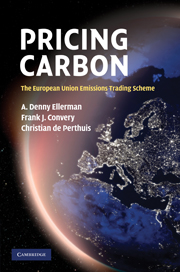Book contents
- Frontmatter
- Contents
- List of figures
- List of tables
- List of boxes
- List of appendices
- Frequently used abbreviations
- Preface
- 1 Introduction
- 2 Origins and development of the EU ETS
- 3 Allowance allocation
- 4 Effects of free allocation
- 5 Market development
- 6 Emissions abatement
- 7 Industrial competitiveness
- 8 Costs
- 9 Linkage and global implications
- 10 Conclusions
- Annex: The interaction between the EU ETS and European electricity markets
- Appendix A Sequence of events in the development of the EU ETS and Linking Directives
- Appendix B Data tables
- Bibliography
- Index
8 - Costs
Published online by Cambridge University Press: 05 July 2011
- Frontmatter
- Contents
- List of figures
- List of tables
- List of boxes
- List of appendices
- Frequently used abbreviations
- Preface
- 1 Introduction
- 2 Origins and development of the EU ETS
- 3 Allowance allocation
- 4 Effects of free allocation
- 5 Market development
- 6 Emissions abatement
- 7 Industrial competitiveness
- 8 Costs
- 9 Linkage and global implications
- 10 Conclusions
- Annex: The interaction between the EU ETS and European electricity markets
- Appendix A Sequence of events in the development of the EU ETS and Linking Directives
- Appendix B Data tables
- Bibliography
- Index
Summary
Introduction
No concept is more debated before the adoption of an environmental programme, and less discussed afterwards, than cost. Typically, a number of ex ante analyses of cost can be found, albeit of varying quality, but few or no ex post evaluations. Part of the problem is that cost can be defined in a number of different ways and from a variety of perspectives. This chapter starts with a discussion of the varying concepts of cost as typically found in analyses, including the important economic distinction between costs and transfers. The next section discusses the several published ex ante studies that have presented some aspects of cost for the first period of the EU ETS. The following section takes an ex post perspective and offers several estimates of what the cost of the EU ETS during the trial period might reasonably have been. The next section addresses an aspect of cost that is often overlooked: transaction costs. These are not the direct costs that are occasioned in reducing emissions but the more indirect costs that are incurred in preparing for and participating in the programme. In this instance, the results of a survey of the transaction costs incurred by Irish installations included in the EU ETS are reported. The final section concludes.
Defining cost
A first important distinction is that between costs and transfers. Strictly speaking, costs reflect resources – labour, capital, energy, etc. – that are devoted to producing a good or service and, thereby, are not available for other uses.
- Type
- Chapter
- Information
- Pricing CarbonThe European Union Emissions Trading Scheme, pp. 235 - 259Publisher: Cambridge University PressPrint publication year: 2010



